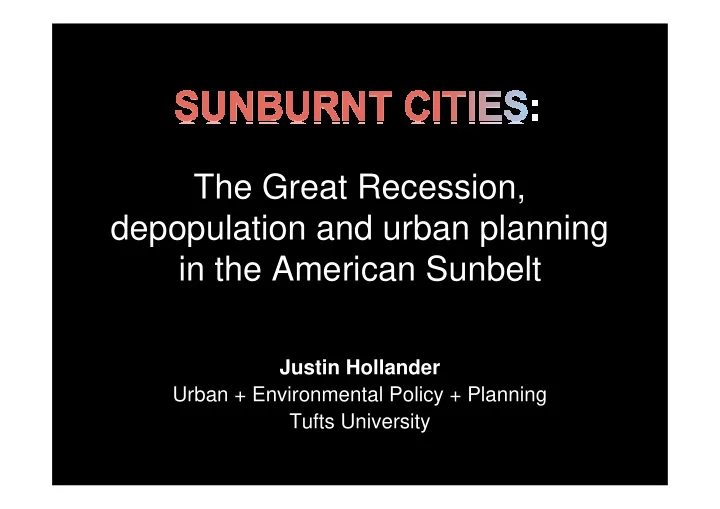

The Great Recession, depopulation and urban planning in the American Sunbelt Justin Hollander Urban + Environmental Policy + Planning Tufts University
Source: Shrinking Cities Project. Office Oswalt, Tim Rieniets. 2006. Accessed 3/2/07. http://www.shrinkingcities.com/fileadmin/shrink/downloads/pressebilder/1_World_Map.pdf
Decline of >1% housing units 2/06 – 2/09 Source: USPS residential delivery data (2009)
� History of the Sunbelt (Worster 1985; Abbot 1981) � Housing / Land Use Changes (1990s – 2006) � Foreclosure Crisis (Immergluck 2009) � Policy/Planning Responses
� Transect Model for smart growth � It is OK to grow, just preserve ecozone integrity � Reverse Transect Model for smart decline � It is OK to decline, just preserve ecozone integrity
How has the Sunbelt physically ① changed? What would Reverse Transect Planning ② look like in the shrinking Sunbelt?
� U.S. Postal Service dataset � Active residential deliveries for all zip codes, 2/06-2/09 � Sunbelt cities � Large (100k +) cities within states located south of 37 th parallel � N=140 cities
� Descriptive statistics; � Correlation analysis with U.S. Census data; � Follow-up ground-truthing through three case studies (Fresno [CA], Phoenix [AZ], and Orlando [FL]).
� Of 140 Sunbelt cities, 26 lost population from 2006-2008; � Among 26 cities, mean loss = 1,660 people (1,603 SD).
CITY STATE JULY ‘08 JUL ‘06 CHANGE ’06-’08 Baton Rouge city Louisiana 223,689 230,369 -6,680 Columbus city Georgia 186,984 191,578 -4,594 Jackson city Mississippi 173,861 177,999 -4,138 Hialeah city Florida 210,542 213,854 -3,312 Long Beach city California 463,789 466,751 -2,962 Pembroke Pines Florida 145,661 148,069 -2,408 city Coral Springs city Florida 125,783 128,023 -2,240 St. Petersburg city Florida 245,314 247,515 -2,201 Hollywood city Florida 141,740 143,853 -2,113 Birmingham city Alabama 228,798 230,733 -1,935 Source: US Census Bureau (2009)
� USPS housing counts from 2006 correlate very highly with U.S. Census housing counts from 2000 (Pearson’s r =0.97) � Among 140 Sunbelt cities, 28 lost housing units from 2/06-2/09; � Among 28 cities, mean loss = 3% of housing units.
� Among 28 shrinking cities, 1,634 valid zip codes; � 1/3 lost housing units, the remainder gained; � 80% of all cities in the study had at least one zip code that lost housing units.
� 564 zip codes lost housing units (out of 1,634 total) � They lost, on average 4% of their housing units (10% SD)
� Protect and Maintain Properties (carrots and sticks); � Get abandoned properties into a “land bank” and turn them over to abutters or repurpose strategically; � Relaxed Zoning Ordinance
� Vacancy is severe and persistent in Sunbelt cities � Local government intervention is ineffective – focus is on growth � Reverse Transect Model suggests opportunities for managing depopulation
Read more…
Justin Hollander, PhD, AICP Assistant Professor Department of Urban and Environmental Policy and Planning Tufts University 97 Talbot Avenue Medford, Massachusetts 02155 USA tel: (617) 627-3394 email: justin.hollander@tufts.edu http://www.tufts.edu/~jholla03 Twitter: JustinHollander Acknowledgements: This research was partially supported through the Faculty Research Award Committee at Tufts University and the Lincoln Institute of Land Policy. Research assistance was provided by Elizabeth Antin, Dan Zinder, and Durwood Marshall. The transect diagram was partially developed by Sarah Spicer and Michelle Moon. Powerpoint design by Paige Mazurek.
Recommend
More recommend